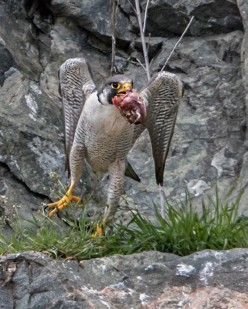David M. Larson
Okay, here’s the scenario. You are hungry, very hungry. No good food supplies around your location. You look across the river and there’s plenty of food there. Problem is, the river might have crocodiles. Oh, and the plentiful food on the other side might be guarded by lions and tigers and bears. Oh my. What do you do?

Peregrine Falcon with prey. Photograph by Sandy Selesky.
If you are on migration, you might be facing this sort of challenge daily. Do you hide in the bushes, relatively safe from predators but hungry, or do you venture out into the open and risk tooth and claw for food? How do migratory birds weigh the trade-offs between predation risk and food? Several single-species studies have shown that hungry birds will risk death for higher quality food resources. McCabe and Olsen (2015) recently published a study designed to answer that question, not just for one avian species, but for a whole suite of frugivorous migratory birds that make refueling stops along the coast of Maine. At six coastal locations, the authors contrasted bird use of safe habitat patches (high woody-plant stem density) and habitats rich in food resources (high fruit abundance).
The authors studied 28 species of migratory passeriform and piciform birds composing the bulk of the migratory landbird community during fall migration. Rarer species were not used for analysis. Some of the study sites provided no trade-off between predation risk and food availability; others presented the birds with a clear dilemma. Factors involved included cover, food availability, and presence of raptors; these varied weekly during the fall based on fruit availability and abundance of avian predators. Since the study examined all 28 commonly caught species of migratory landbirds, it was possible to contrast habitat use of long-range and short-range migrants. The high energetic demands of long-range migration might predispose those birds to more risky food gathering.
At two coastal headlands and on four islands, the authors captured birds using multiple passive mist nets and assessed vegetation within four meters around each net during two fall migration seasons. All nonmigratory species were excluded from the analysis, as were all nonfrugivorous species. Individual birds were weighed, measured, aged, sexed, banded, and scored for fat. The authors recorded raptor abundance by counting all birds of prey visiting the banding sites during hours of operation. The most common raptor species recorded were Merlin, Sharp-shinned Hawk, and Peregrine Falcon. Habitat patch measurements included woody-plant stem densities, using standard techniques. Ripe fruit abundance was determined weekly and excluded bayberry, which only Yellow-rumped Warblers used. The researchers assessed each mist net/vegetation patch weekly to determine whether the fruit and stem densities were both high or low (nontrade-off sites) or one was high and the other low (trade-off sites). Due to the phenology of fruiting, sites could switch characteristics from week to week during the season, so they expressed the trade-off/nontrade-off metric in site-weeks.
The researchers captured nearly 10,000 migrant birds at the six banding stations. In the statistical modelling of the variables (fruit, trade-off, stem density, migration distance, raptor abundance), a trade-off status was present for 15 site-weeks and absent for 46 site-weeks. The top-ranked model for predicting variability in patch use combined fruit availability and migration distance, while controlling for the other variables. However, within that model, the authors found important effects of week, year, trade-off status, raptor abundance, and stem density. Controlling for all other variables, birds preferred patches with thick cover (higher stem densities). Fruit availability was less important to short-range migrants and more important to the longer-range migrants.
Contrary to the authors’ initial prediction, birds preferred dense cover whether or not trade-offs were present. In addition, fruit abundance was only predictive of patch use for the longest-distance migrants. Overall, bird abundance was highest in sites without trade-offs, meaning that these are smart birds. This finding is consistent with a hypothesis that migrating birds rapidly select refueling sites based on the quality of cover and resources, and are willing to take longer to refuel in safety. However, long-range migrants have tighter time constraints and seem more willing to risk safety for faster refueling stops.
This research project demonstrates that an entire community of migratory frugivores shows preferences for high-quality, safe, stopover locations. A clear suggestion from this paper is that migratory bird conservation does not depend just on protecting breeding and wintering grounds, but also on providing high-quality migratory stopover sites for refueling, as shorebird biologists have long known.
References
- McCabe, J.D., and B.J. Olsen. 2015. Tradeoffs between predation risk and fruit resources shape habitat use of landbirds during autumn migration. The Auk 132 (4): 903-13.
David M. Larson, PhD, is the Science and Education Coordinator at Mass Audubon’s Joppa Flats Education Center in Newburyport, the Director of Mass Audubon’s Birder’s Certificate Program and the Certificate Program in Bird Ecology (a course for naturalist guides in Belize), a domestic and international tour leader, Vice President of the Nuttall Ornithological Club, and a member of the editorial staff of Bird Observer.